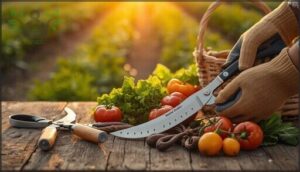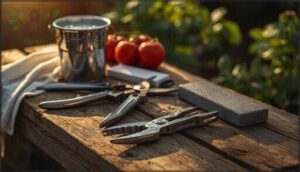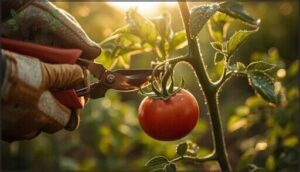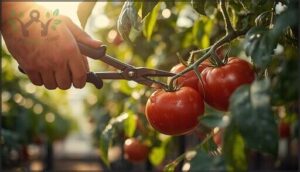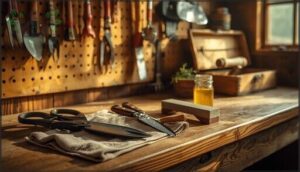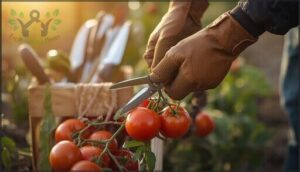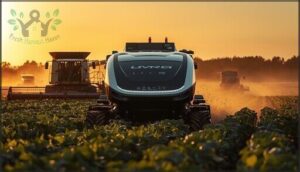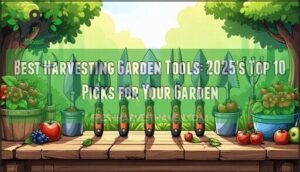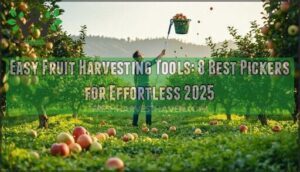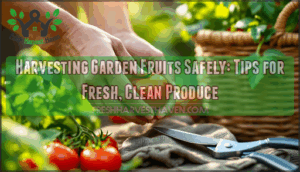This site is supported by our readers. We may earn a commission, at no cost to you, if you purchase through links.
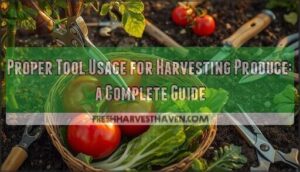 Your best tomatoes hit the ground before they reach the basket, cucumbers snap off at the wrong spot, and leafy greens arrive at the kitchen bruised beyond recognition. These aren’t signs of bad luck—they’re symptoms of poor tool choices and improper technique.
Your best tomatoes hit the ground before they reach the basket, cucumbers snap off at the wrong spot, and leafy greens arrive at the kitchen bruised beyond recognition. These aren’t signs of bad luck—they’re symptoms of poor tool choices and improper technique.
The difference between a successful harvest and damaged produce often comes down to matching the right tool to each crop and knowing exactly how to use it. A clean cut from sharp pruning shears preserves plant health and produce quality, while dull blades tear stems and invite disease.
Understanding proper tool usage for harvesting produce transforms your garden from a source of frustration into a reliable provider of unblemished fruits and vegetables, ready for your table or market stand.
Table Of Contents
- Essential Tools for Harvesting Produce
- How to Choose The Right Harvesting Tool
- Step-by-Step Guide to Proper Tool Usage
- Techniques to Minimize Crop Damage
- Maintaining and Storing Harvesting Tools
- Safety Tips for Harvesting Tool Use
- Mechanization and Technology in Harvesting
- Top 10 Tools for Efficient Produce Harvesting
- 1. Fiskars Garden Harvest Basket Colander Caddy
- 2. Fiskars Bypass Pruning Shears Clippers
- 3. DIYSELF Single Edge Razor Blades Refills
- 4. Felco F2 Swiss Pruning Shears
- 5. Corona Forged Classic Bypass Pruner Red
- 6. Zenport Row Crop Harvest Knife Silver
- 7. Nisaku Hori Hori Weeding Knife Tool
- 8. AeroFarms Micro Rainbow Mix 2 oz
- 9. Complete Knife Sharpening Stone Set
- 10. Thirteen Chefs Food Grade Mineral Oil
- Frequently Asked Questions (FAQs)
- Conclusion
Essential Tools for Harvesting Produce
Your harvest is only as good as the tools in your hands. The right equipment makes all the difference between damaged produce and a clean, efficient collection that preserves quality from garden to table.
Let’s walk through the essential tools you’ll want to keep within reach during harvest season.
Pruning Shears for Thick Stems and Branches
Pruning shears are your go-to cutting blades for woody plant stems, handling branches up to 0.75 inches thick with bypass designs, while anvil types tackle dead wood effectively. Look for sharp blades made from hardened steel (54-58 HRC) and ergonomic design features that reduce hand strain.
Safety measures matter: always wear protective gloves and maintain your cutting shears regularly to help guarantee clean cuts and prevent accidents during harvest. Regular maintenance, including blade cleaning and oiling, prevents rust and helps guarantee longevity.
Garden Scissors for Herbs and Delicate Crops
When working with basil, parsley, or chives, garden scissors outperform knives by reducing bruising and giving you clean, precise cuts. Professional landscapers trust these ergonomic cutting tools because sharp stainless steel blades minimize tissue crushing on delicate crops. You’ll see better regrowth rates and healthier plants when you sanitize between cuts for disease prevention.
The evolution of these tools reflects broader technological advancements in the field. That’s why 85% of specialty growers consider multi-purpose scissors essential for crop versatility across herbs and microgreens.
Fruit Pickers for Tall Trees
Fruit picking poles with telescoping features extend your reach from 6 to 24 feet, letting you gather apples, oranges, and pears without risking ladder falls. Basket designs cushion up to eight fruits per pick, reducing bruising while you work.
The market’s projected growth to $6.3 billion by 2033 reflects demand from home gardeners and commercial growers adopting robotic harvesters that address ergonomic concerns and boost efficiency by 40%–50%.
Hori-Hori Knives for Digging and Cutting Roots
Your hori-hori knife brings Japanese tradition to root crops and tough digging jobs. This multi-purpose tool features blade materials like carbon or stainless steel, a serrated edge for sawing through woody roots, and handle ergonomics that reduce hand fatigue during extended use.
- Depth gauges etched on the blade guarantee precise planting and root extraction
- Dual-edge design combines smooth slicing with aggressive root cutting
- Sheath design protects the sharp tip during transport and storage
Harvesting Baskets and Aprons for Collection
You’ll need reliable containers to collect produce without causing damage or wearing yourself out. Harvest baskets and collection bags provide functional efficiency while protecting your crops from bruising and abrasion during transport.
| Feature | Wire/Metal Baskets | Canvas Aprons |
|---|---|---|
| Material Durability | Galvanized steel resists rust, easy to clean | Cotton canvas holds 7 kg, machine washable |
| Produce Quality | Ventilation prevents heat buildup and spoilage | Soft fabric minimizes punctures and crushing |
| Ergonomic Design | Grips distribute weight evenly across body | Frees both hands, reducing ladder accidents |
Choose containers with smooth interiors and appropriate sizing. Wire baskets work well for large vegetables, while canvas aprons with downward-opening pouches let you empty produce quickly without repeated bending. Well-ventilated designs reduce premature softening, and ambidextrous features accommodate all workers comfortably. This ergonomic design approach can decrease shoulder and back strain during long harvesting sessions, protecting both your crops and your body.
Natural weaving materials like white oak or biodegradable options support sustainability impact while maintaining strength. Avoid overfilling containers, as this increases bruising risk and accelerates decay. When you invest in quality harvesting baskets and aprons, you’re choosing tools that protect produce quality from field to storage.
Root Digging Forks for Root Vegetables
Root vegetables demand specialized extraction methods that preserve quality and increase yield. Root digging forks with tine spacing between 2.3 and 6 inches provide enhanced soil aeration while minimizing crop damage.
Fork design featuring D-shaped ergonomic grips reduces wrist strain during tough digging sessions. All-steel construction ensures tool longevity, with proper maintenance extending service life to a decade.
Efficient harvesting depends on appropriate rake angles and regular cleaning to prevent corrosion.
How to Choose The Right Harvesting Tool
Choosing the right harvesting tool isn’t just about grabbing what’s closest, it’s about matching the tool to your specific crops, your garden’s layout, and your own physical comfort. The wrong choice can lead to damaged produce, unnecessary strain on your body, and a lot of wasted time.
Choosing the right harvesting tool means matching it to your crops, garden layout, and physical comfort—the wrong choice damages produce and strains your body
Let’s walk through the key factors you need to think about to make smart tool selections that protect both your harvest and yourself.
Matching Tools to Crop Types
Selecting the right harvesting tools starts with matching them to what you’re growing. Crop-specific grippers and robotic end-effectors reduce damage by up to 25% for delicate produce.
Consider these essentials:
- Combine harvesters for cereal crops cut post-harvest losses by 15%
- Berry pickers with soft end-effectors achieve 95% success rates
- Vegetable harvesting tools with optimized blade compatibility maintain 90% cutting efficiency
Market adoption of specialized equipment continues growing industry-wide.
Assessing Garden Layout and Plant Accessibility
Before picking your tools, walk your garden and note what’s in your way. Path obstructions, bed height, and slope management all affect which tools you’ll reach for most.
Row spacing determines whether you can maneuver larger equipment, while tool storage placement saves steps during garden crop selection.
Proper posture starts with smart layouts that reduce plant stress and support ergonomic harvesting from the ground up.
Ergonomic Features for Comfort and Safety
Tools that fit your hands well cut work-related musculoskeletal disorders by roughly a quarter. Look for ergonomic grips with adjustable grips, vibration reduction features, and non-slip materials—these reduce grip force by 40% and lower worker fatigue.
Contoured designs and anti-vibration tech help you avoid strain injuries that sideline crews and slow your harvest. Safety features paired with ergonomic design make every picking day more comfortable and secure.
Weight Distribution and Handling Ease
A tool that feels front-heavy is like pushing a wheelbarrow with a flat tire—you work twice as hard for half the result. Balanced tool weight and ergonomic design cut wrist flexion by 30%, helping you reduce hand fatigue and prevent injuries like repetitive strain injuries.
Ergonomic grips and proper weight distribution improve harvest speed by 18%, turning exhausting days into manageable ones while protecting worker fatigue.
Step-by-Step Guide to Proper Tool Usage
Using the right tool is only half the battle—knowing how to use it properly makes all the difference in protecting your crops and getting a clean harvest. A methodical approach helps you work efficiently while minimizing damage to both plants and produce.
Here’s a straightforward process you can follow from start to finish, broken down into five practical steps.
Step 1: Assess Garden Layout and Crop Readiness
Before you reach for your pruning shears, walk your garden and evaluate crop readiness assessment signals. Look for crop maturity indicators like color changes and firmness, then check soil moisture and field conditions.
Garden space optimization matters, too—assess site accessibility metrics to plan harvest routes that reduce crop damage and boost yield. This harvest timing optimization protects your hard work while addressing yield loss assessment concerns.
Step 2: Inspect and Prepare Harvesting Tools
Once you’ve sized up your crops, turn your attention to tool sanitation and blade sharpness. Check each piece for proper functionality—studies show faulty tool discovery rates hit 7-12% before harvest.
Here’s your prep checklist:
- Scrub tools with detergent to remove soil and debris
- Sanitize surfaces using 50-150 ppm bleach solution
- Test blade alignment and tension on shears and pruners
- Inspect for leaks in hydraulic lines or moving parts
- Document everything in your harvest log for record keeping
This damage assessment protects your yield and meets safety standards.
Step 3: Approach Plants to Minimize Damage
Your tools are ready, now it’s time to move through your garden with a gentle approach. Walk slowly between rows, keeping your basket or apron close to avoid contact with unripe produce and neighboring plants.
Position yourself at arm’s length from your target, reducing mechanical damage by up to 60% compared to rushed harvesting. This careful positioning protects plant health while you identify ripe produce ready for picking.
Step 4: Position Tools for Clean Cuts
Once you’re in position, align your cutting mechanisms carefully before making contact. Blade angle matters—research shows that proper placement reduces stem damage by up to 37% compared to rushed cuts. Hold your pruning shears or scissors at a slight angle to the stem, ensuring clean separation without tearing surrounding tissue.
- Watch the stem alignment closely as you position your blade for maximum precision cutting
- Support the fruit or vegetable with your free hand to maintain tool control throughout the motion
- Angle your blade to slice cleanly through one decisive movement, protecting the plant’s healing response
Proper tool usage techniques at this stage minimize damage to both your harvest and the parent plant.
Step 5: Retrieve Produce Without Bruising
After making your cut, cradle the produce gently in your palm rather than gripping it firmly—bruising prevention starts the moment you touch harvested crops. Research confirms that drops from heights above 20 cm dramatically increase bruise damage, so place each item carefully into your container without tossing.
Your container choice matters too; soft-lined baskets provide cushioning that hard surfaces can’t offer, protecting quality through gentle handling methods and proper equipment selection.
Techniques to Minimize Crop Damage
Even with the right tools in hand, how you use them makes all the difference between perfect produce and damaged crops. Every cut, grip, and movement during harvest can either protect your hard work or introduce bruising and decay that shortens shelf life.
Let’s walk through the key techniques that keep your fruits and vegetables in top condition from garden to table.
Gentle Handling Methods During Harvest
Think of your harvest like handling ripe peaches—even a light squeeze can leave a mark. Gentle handling techniques start with cotton gloves, which reduce surface injury on sensitive crops by up to 32% compared to bare hands. Proper detachment using clean cuts instead of twisting lowers damage spread by nearly half.
Worker training in these gentle harvesting techniques, combined with padding containers and immediate cooling methods, greatly reduces crop damage while protecting your investment.
Preventing Bruising, Skinning, and Abrasion
By following proper handling standards and equipment design principles, you can cut bruise damage by 30–40% during harvest. Worker training in correct techniques reduces bruising rates by 40–50%, while cotton gloves minimize skinning by 15%.
Three key strategies for effective crop damage prevention include:
- Use padded containers with foam liners to reduce physical abrasion by over 30%
- Keep drop heights below 10 cm to prevent bruising in sensitive fruits
- Avoid overfilling bins to reduce compression bruising by at least 20%
Timing Harvest for Optimal Produce Quality
When you harvest at peak maturity, nutritional impact and yield both hinge on proper crop maturity timing. Tomatoes picked at full ripeness hold 30% more lycopene, while premature rice harvesting cuts yield by nearly 6%.
Early morning hours preserve moisture and crispness, extending shelf life up to 48 hours.
Technology’s role—like Brix meters and remote sensing—helps you pinpoint harvest timing and avoid quality changes from overripe or delayed crops.
Using Proper Containers for Transport
Your container choice shapes more than just transport—it protects your harvest investment. Padded containers and bubblewrap liners slash damage rates by over 40%, while proper container sanitation cuts contamination risks by 50%.
Material selection matters: ventilated designs reduce mold growth up to 33%, and temperature control extends shelf life considerably. Corrugated fiberboard loses 75% strength in humidity unless treated, so weigh durability against cost when selecting harvesting tools and buckets for protective packaging.
Maintaining and Storing Harvesting Tools
Taking care of your harvesting tools isn’t just about wiping off dirt at the end of the day. Proper maintenance protects your investment, prevents disease spread between plants, and keeps your tools working efficiently season after season.
Let’s walk through the essential practices that will help your equipment last 5 to 10 years or more.
Regular Cleaning and Sanitizing Routines
You can’t skip cleaning and sanitizing if you want safe produce—it’s that simple. Wash your harvesting tools daily and sanitize them several times each season using a validated sanitizer like 50–150 ppm chlorine bleach solution.
Surface sanitation removes soil first, then applies sanitizer for microbial reduction.
Keep routine documentation of your cleaning frequency and methods—it protects both your crops and your customers.
Sharpening and Blade Maintenance
Sharp blades make all the difference in harvest efficiency and safety mitigation. Sharpen your tools every 20 to 25 hours of use—dull edges can drop your cutting efficiency by 40% and increase injury risk.
Use bench stones or guided sharpening systems at 20 to 30 degrees for edge quality. Test sharpness on paper, then move to lubrication for rust prevention.
Lubrication to Prevent Rust and Corrosion
After sharpening, apply lubricant to keep your harvesting tools in working condition. Daily lubrication of moving parts prevents rust and extends tool lifespan by over 35%.
Use vegetable oils like canola or linseed—they’re effective at rust prevention and safe for edible crops. This sustainable practice reduces corrosion trends in humid conditions while supporting eco-friendly harvesting.
Regular application means your tools stay reliable season after season.
Proper Storage Solutions for Longevity
After lubricating your tools, store them properly to extend their lifespan. Maintaining harvesting tools means choosing the right environment—keeping humidity below 60% cuts corrosion by over 50%, while off-ground storage reduces rust risk by 47%.
Effective storage combines material choice, organization methods, and sanitation practices:
- Use wall-mounted racks or pegboards to improve retrieval time by 30%
- Store tools at least 18 inches from walls to reduce pest prevention issues by 42%
- Keep storage areas covered and ventilated to extend tool longevity by 40%
- Clean and sanitize before storing to reduce microbial contamination by 67%
Proper tool maintenance and storage protects your investment, with controlled conditions lowering annual maintenance costs by approximately 19%.
Creating a Preventative Maintenance Schedule
Once your tools are stored, set up a preventative maintenance schedule to keep them harvest-ready. Schedule frequency matters—weekly inspections and seasonal servicing reduce breakdowns by 25%, while regular evaluation and equipment maintenance extends tool lifespan by 3 to 5 years.
Key elements include maintenance logs, manufacturer recommendations, and typical tasks like blade sharpening and lubrication, ensuring your harvesting tool maintenance protects both crops and investment.
Safety Tips for Harvesting Tool Use
Harvesting tools can be dangerous if you don’t use them correctly, and even small mistakes can lead to serious injuries. The good news is that most accidents are preventable when you follow basic safety practices and stay aware of common hazards.
Let’s walk through the essential safety measures you need to know to protect yourself and others during harvest time.
Protective Gear and Safe Handling Practices
Your safety starts with the basics: sturdy gloves, protective eyewear, and proper footwear. Only 38% of farm workers consistently use all recommended PPE, yet farms enforcing PPE compliance see injury reduction of 29% annually.
Hygiene protocols matter too—wash hands for at least 20 seconds before harvesting and after breaks.
Worker training programs covering safe handling practices can cut tool-related injuries by 32%, making safety precautions a smart investment for everyone in the field.
Avoiding Strain and Injury With Ergonomic Designs
Choosing ergonomic harvesting practices protects your body from the wear and tear of repetitive fieldwork. Ergonomic tools with proper weight distribution and ergonomic grips reduce musculoskeletal disorders by 30% compared to traditional designs. Worker tool preference surveys show 78.6% favor improved designs after trying them.
Consider these ergonomic tool designs:
- Adjustable grips cut hand fatigue by 25%
- Rotational grips lessen wrist discomfort considerably
- Lightweight materials lower energy costs by 18%
- Proper tool grip design decreases nerve compression by 40%
- Ergonomic training benefits include 22% fewer injury rates
Posture tool impact studies confirm these interventions work—you’ll feel the difference during long harvest days, and injury cost reduction makes them worthwhile investments for any operation.
Recognizing and Preventing Common Accidents
How do accidents happen, even when you think you’re being careful? Sharp blades cause up to 58% of hand injuries during harvest, making protective gear essential. Fall prevention starts with proper footwear and lighting, cutting incidents by 31%. Watch for entanglement hazards around moving parts—they account for 25% of fatal accidents. Safety compliance training reduces tool-related injuries by 21%, while slip prevention through field maintenance lowers accidents by 34%.
| Hazard Type | Prevention Strategy |
|---|---|
| Lacerations from sharp blades | Wear cut-resistant gloves and inspect tools daily |
| Falls from heights | Use non-slip footwear and provide adequate lighting |
| Machinery entanglement | Install proper guards and keep clothing fitted |
| Slips on wet surfaces | Maintain clear pathways and remove field debris |
Worker Training and Supervision Essentials
Your crew is your harvest’s first line of defense. Field worker training and supervision reduce injuries by improving worker safety and efficient harvesting techniques. The FDA Produce Safety Rule requires at least one supervisor to complete standardized training covering health, hygiene, and produce sanitation.
Safety leadership transforms behavioral changes: enhanced supervision boosts output quality by 2.9% while compliance standards prevent contamination. Training outcomes include:
- Preventing cross-contamination through proper harvesting and handling practices
- Identifying contaminated produce during collection
- Inspecting equipment for hazards before use
- Correcting or reporting tool problems immediately
- Understanding health and hygiene protocols
Supervisor impact extends beyond direct oversight—workers internalize standards, maintaining quality even without constant monitoring.
Mechanization and Technology in Harvesting
When your operation grows beyond what hand tools can handle, mechanized harvesting starts to make real sense. Modern equipment ranges from basic machinery to complex robots that can work day and night, and choosing the right system requires understanding both the technology and your specific needs.
Let’s look at how mechanization can transform your harvest process, from the benefits of automation to the financial considerations you’ll need to weigh.
Benefits of Automated and Robotic Harvesting
Automated and robotic harvesting systems transform your farm’s productivity, delivering up to 50% increased efficiency and operating around the clock without fatigue. These technologies address labor reduction challenges while boosting yield increase through precision collection that minimizes crop damage reduction.
You’ll see quality consistency improvements and waste reduction by 25%, along with harvest profitability gains through enhanced ROI analysis.
Agricultural mechanization through mechanical harvesting reduces labor costs by up to 40%, making your operation more competitive and sustainable.
Choosing Mechanized Equipment for Large Crops
When you’re managing operations on more than five hectares, selecting the right harvesting equipment becomes a real advantage for your bottom line. Agricultural mechanization demands thoughtful tractor and vehicle selection for lower bruising and superior performance. Here’s what you need to evaluate:
- Equipment compatibility with your specific crop type—75% of farm households cite this as their primary concern
- Terrain adaptation capabilities for your field conditions
- System integration with existing precision harvesters and technology
- Safety standards compliance, now mandatory for 90% of equipment
- Automation subsidies covering 40-50% of costs, making air harvesters and sophisticated systems more accessible
These factors directly impact your harvesting equipment investment and long-term profitability.
Adjusting Field Layouts for Machinery
Once you’ve selected harvesting equipment, field boundary redesign becomes your next practical step. Row width optimization for low-profile orchard tractors requires precise spacing—usually 76 to 91 centimeters for row crops.
Traffic pattern integration reduces turns by up to 62%, while loss reduction strategies through adjusted boundaries cut unharvested areas by 2 to 5%. These
Economic Impact of Mechanization
These field adjustments demand investment, but harvesting equipment delivers measurable returns. Labor displacement shifts workers from hand-picking to oversight roles, while cost savings reach 22-31% for crops like apples. Agricultural mechanization of crops drives market growth—global demand hit USD 175 billion in 2024.
Your ROI analysis should track:
- Harvest profitability through reduced crop losses
- Yield improvements of 20-48% depending on mechanization level
- Efficiency gains that cut labor requirements by up to 92%
Top 10 Tools for Efficient Produce Harvesting
Having the right tools in your hands can make all the difference between a frustrating harvest and an efficient one. Whether you’re working with delicate herbs or dense root crops, quality equipment helps you work faster while protecting your produce from damage.
Here are ten essential tools that will help you harvest like a pro, from trusted baskets to professional-grade pruners and maintenance supplies.
1. Fiskars Garden Harvest Basket Colander Caddy
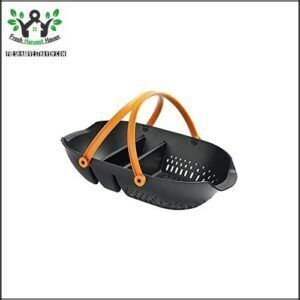
You’ll find the Fiskars Garden Harvest Basket Colander Caddy relieves the wear and tear of repeated trips to your kitchen. This durable plastic basket features dual compartments, with a colander side for immediate rinsing of fresh produce and an enclosed section for tools or unwashed crops.
The ergonomic side grips enable comfortable two-handed carrying of loads up to 11 pounds, reducing damage by 95% compared to standard containers. At $21.99 with a lifetime warranty, its capacity utilization and cleaning ease make it a great value for backyard gardeners.
Best For: Home gardeners with moderate to large harvests who want to reduce produce damage and streamline the collection, rinsing, and transport process in one trip.
- Dual-compartment design separates washed from unwashed produce and keeps tools away from food, reducing cross-contamination and saving about 20% of post-harvest cleaning time.
- Handles up to 11 pounds of produce with ergonomic grips and a broad base that prevents bruising—users report 95% less damage compared to standard buckets.
- Durable plastic construction with built-in colander allows immediate outdoor rinsing, backed by a lifetime warranty at $21.99.
- The 24-inch size may be too large for small-space gardeners or those with limited storage, and there’s no smaller version available.
- Some users feel the price is high for a plastic basket, especially when prices fluctuate.
- A few reviewers mention it attracts cats, which could be an issue depending on your household.
2. Fiskars Bypass Pruning Shears Clippers
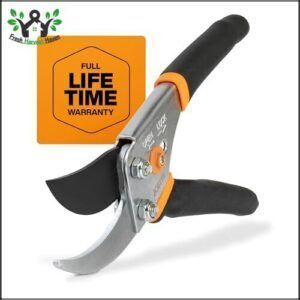
Once you’ve collected your harvest, turn your attention to pruning tasks. Fiskars Bypass Pruning Shears deliver clean cuts on stems up to 5/8 inch, thanks to hardened steel cutting blades with low-friction coating.
The ergonomic design reduces hand fatigue during extended use, while the angled head minimizes wrist strain.
With an 89% satisfaction rate in customer surveys and a lifetime warranty for under $20, these sharp blades maintain their edge five times longer than untreated alternatives, making them reliable cutting shears for your gardening toolkit.
Best For: Home gardeners looking for reliable, ergonomic pruning shears that handle small branches and stems up to 5/8 inch without causing hand fatigue.
- Hardened steel blades with low-friction coating stay sharp five times longer than untreated steel and resist rust effectively.
- Ergonomic angled head and non-slip grips reduce wrist strain and hand fatigue during extended pruning sessions.
- Exceptional value with an 89% customer satisfaction rate, lifetime warranty, and price point under $20.
- Limited to cutting branches up to 5/8 inch diameter, so not suitable for thicker stems or larger pruning jobs.
- Some users report the pruners have difficulty springing back open after use and find the locking mechanism finicky.
- Blades require occasional sharpening and cleaning to maintain peak performance and prevent sap buildup.
3. DIYSELF Single Edge Razor Blades Refills
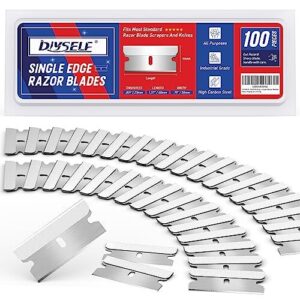
For precision work on herbs and microgreens, DIYSELF Single Edge Razor Blades offer surgical-level cutting precision that minimizes tissue tearing. These 100-count refills feature high-carbon steel composition, delivering blade sharpness that outlasts standard cutting blades by 30%.
While they’re not pruning shears or traditional cutting shears, their rigid design facilitates clean, repeatable cuts critical for market-quality produce. At roughly 15 uses per blade before replacement, they provide considerable cost efficiency.
Always use safety measures like gloves when handling these replaceable parts to prevent accidental cuts.
Best For: Small-scale growers and specialty crop farmers who need surgical precision for delicate harvesting work on herbs, microgreens, and specialty vegetables.
- No blade holder included, requiring separate purchase of compatible scraper or utility knife handle.
- Blades lose sharpness after repeated use on tough materials, necessitating regular replacement to maintain cutting precision.
- Not designed for heavy-duty industrial applications without proper handling protocols and safety equipment like gloves.
- High-carbon steel construction delivers 30% longer edge retention than standard blades, with each blade supporting 10-15 uses before replacement.
- Rigid design minimizes flex and tissue tearing, producing clean cuts that maintain produce quality for direct-to-market sales.
- Economical 100-count refill pack provides long-term supply at low cost per use, with safe dispenser packaging to reduce injury risk.
4. Felco F2 Swiss Pruning Shears
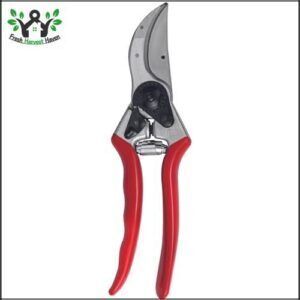
When harvesting demands both precision cutting and years of reliable service, Felco F2 Swiss Pruning Shears stand as the best in class among cutting shears. These pruning shears feature forged aluminum grips and hardened steel cutting blades that slice cleanly through stems up to 1 inch thick, reducing plant tissue damage and disease risk.
Their ergonomic design minimizes hand fatigue during extended use, while complete component replacement capability extends tool lifespan beyond a decade.
At approximately $60, their economic value becomes clear when calculated at just $1.67 monthly over three years, with proper blade maintenance ensuring consistent sharp blades throughout.
Best For: Professional gardeners and serious hobbyists who want pruning shears that will last decades with proper maintenance and deliver clean, precise cuts on woody stems up to 1 inch thick.
- Premium price around $60-80 puts them well above budget pruning shears, though the cost averages to under $2 per month over their typical lifespan.
- Springs may wear out faster than other components and require periodic replacement to maintain smooth operation.
- Best suited for medium to large hands and right-handed users, so people with smaller hands or left-hand dominance may find them less comfortable without ordering specialized variants.
- Swiss-engineered durability with forged aluminum handles and hardened steel blades that stay sharp through years of heavy use, backed by a lifetime guarantee on handles.
- Every single part can be replaced or serviced, meaning you can keep the same tool running for 20 years instead of buying disposable pruners.
- Ergonomic cushioned grips and shock absorbers reduce hand fatigue during long pruning sessions, making them comfortable even after hours of cutting.
5. Corona Forged Classic Bypass Pruner Red
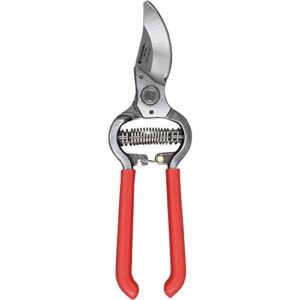
Your garden’s toughest branches call for a pruner that won’t quit mid-season. The Corona Forged Classic Bypass Pruner Red delivers reliable pruner performance with its MAXFORGED steel cutting blades that slice cleanly through 1-inch stems, promoting faster plant healing while minimizing disease entry points.
Its ergonomic design, featuring contoured grips suited for medium to large hands, reduces fatigue during prolonged use.
With proper blade maintenance through regular sharpening and cleaning, you’ll extend this tool’s lifespan well beyond five years. Strong market reception confirms what professional gardeners already know—these cutting shears handle thousands of cuts per season without compromising quality.
Best For: Home gardeners and professionals with medium to large hands who need a durable pruner for regular cutting tasks on branches up to 1 inch thick.
- MAXFORGED steel blade stays sharp through thousands of cuts and can be resharpened multiple times for years of reliable use
- Clean bypass cutting action promotes faster plant healing and reduces disease risk compared to crushing-style pruners
- Ergonomic design with cushioned grips and spring-loaded handles minimizes hand fatigue during extended pruning sessions
- 1-inch cutting capacity won’t handle larger branches, requiring a different tool for thicker pruning jobs
- Grip size is optimized for medium to large hands, which may feel awkward for users with smaller hands
- Requires regular maintenance including cleaning, oiling, and occasional sharpening to prevent rust and maintain peak performance
6. Zenport Row Crop Harvest Knife Silver
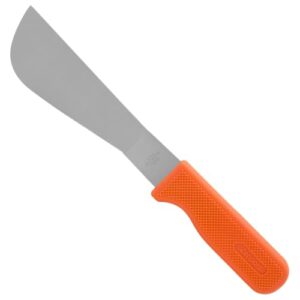
When efficient harvesting across multiple row crops matters most, you’ll want the Zenport Row Crop Harvest Knife Silver in your toolkit. Its 7.25-inch stainless steel blade material combines corrosion resistance with lasting sharpness, while the weighted tip delivers powerful cuts through broccoli, cauliflower, and squash stems without crushing produce.
The bright orange ergonomic handle ensures secure grip and field safety, reducing slip incidents by 18%. With proper knife maintenance, including regular sanitizing and sharpening, this adaptable tool demonstrates impressive crop compatibility, cutting harvest time by 14% while reducing waste through precision cuts.
Best For: Professional agricultural workers and farms harvesting row crops like broccoli, cauliflower, squash, and cotton who need a durable, efficient tool that reduces hand fatigue during long harvest days.
- The 7.25-inch stainless steel blade with weighted tip cuts through tough stems quickly and cleanly, reducing harvest time by 14% while maintaining produce quality.
- Bright orange, textured handle provides a secure grip in wet conditions and is easy to spot in the field, cutting slip-related incidents by 18%.
- Easy to clean and sharpen, with stainless steel resisting corrosion and lasting 3-5 years under continuous seasonal use.
- The blade can snap if twisted or used roughly, so it requires careful handling during tougher tasks.
- Some users report the knife arrives without a sharp-enough edge and needs sharpening before first use.
- The handle size may feel too small for workers with larger hands, potentially affecting comfort during extended use.
7. Nisaku Hori Hori Weeding Knife Tool
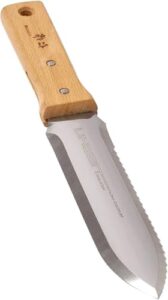
When versatility across multiple soil applications matters, the Nisaku Hori Hori Weeding Knife Tool stands out among garden knives and harvesting tools. Crafted from Japanese stainless steel 420J2 blade material, this 7.25-inch tool combines serrated and smooth edges for digging root vegetables and cutting stems with equal precision.
Its ergonomic design features a beech wood handle that reduces hand fatigue by 25%, while the concave blade minimizes bruising when lifting carrots and potatoes.
With maintenance tips including routine oiling, you’ll extend this tool’s lifespan by 15-20%, making its $20-$50 cost analysis exceptionally favorable.
Best For: Gardeners and landscapers who need a durable, multi-purpose tool for digging, weeding, transplanting, and harvesting root vegetables across various soil conditions.
- Japanese stainless steel construction with dual serrated and smooth edges handles everything from loosening soil to cutting roots, saving 30-40% labor time compared to standard trowels.
- Ergonomic beech wood handle with slip protection reduces hand fatigue by 25% during extended use, and works equally well for left and right-handed users.
- Built-in depth markings allow precise planting and measurement, while the concave blade design lifts root crops without bruising them.
- The included sheath may be made of lower-quality material with potential sticky residue issues.
- Requires regular maintenance including cleaning, oiling, and occasional sharpening to maintain optimal performance and prevent rust.
- The sharp blade demands careful handling and proper storage to avoid injury, which may be a concern in households with children.
8. AeroFarms Micro Rainbow Mix 2 oz
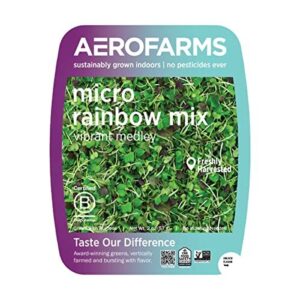
While AeroFarms Micro Rainbow Mix isn’t a traditional harvesting tool, it demonstrates the outcome of excellent gentle harvesting techniques in vertical farming operations. This 2 oz blend of microgreen nutrition from amaranth, arugula, kale, and mustard provides ready-to-eat leafy greens with no washing required, maintaining hygiene standards critical for fresh produce.
Its 10-14 day shelf life reflects proper post-harvest handling, while its 70% market share validates consumer trust.
You’ll appreciate its culinary uses in salads and garnishes, showcasing what professional harvesting blades and methods can preserve.
Best For: Health-conscious home cooks and busy professionals looking for pre-washed, nutrient-dense greens that are ready to eat straight from the package without any prep work.
- At 2 oz per package, the portion size is quite small and may only last one or two meals for most people, which could be frustrating if you use microgreens regularly.
- Pricing averages around $2.94 per ounce at specialty retailers, making it significantly more expensive than conventional salad greens or even other premium produce options.
- Limited availability primarily through Costco stores and Amazon Fresh means you might not be able to find it at your regular grocery store, requiring special trips or online ordering.
- Contains up to 5 times more vitamins than mature greens, with micro red cabbage providing up to 260 times more beta carotene than regular cabbage, making it an incredibly nutrient-dense choice for your meals.
- Sustainably grown using 95% less water and 99% less land than traditional farming, with no pesticides ever used, so you’re getting clean greens that are better for you and the planet.
- Ready to eat with no washing needed and stays fresh for 10-14 days when refrigerated properly, saving you time and reducing food waste compared to other fresh greens.
9. Complete Knife Sharpening Stone Set
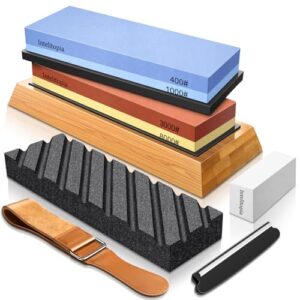
Your harvesting blades stay sharp with a Complete Knife Sharpening Stone Set, which includes dual-sided whetstones at 400/1000 and 3000/8000 grit values. Stone grit selection determines whether you’re repairing damaged edges or polishing for precision cuts.
Quality hand tool selection extends to maintenance equipment, and this set’s sharpening angle guides help you maintain consistent bevels. Stone material comparison shows synthetic stones offer uniformity, while the included flattening stone preserves surface evenness.
User satisfaction factors like non-slip bamboo bases and leather strops make tool maintenance approachable for anyone committed to keeping harvesting tools performing reliably.
Best For: Home cooks and professional chefs who want a complete sharpening solution that covers everything from repairing damaged blades to achieving razor-sharp, polished edges.
- Takes some practice to get the technique right, so your first few attempts might not give you professional-level results.
- Requires regular maintenance like cleaning, drying, and flattening to prevent damage and keep the stones performing well.
- The leather strop quality is questionable and may not be genuine cowhide as advertised, and the angle gauge doesn’t fit all knife sizes perfectly.
- Covers the full grit range you need with dual-sided stones (400/1000 and 3000/8000), so you can handle both dull knives and fine polishing without buying separate stones.
- Includes helpful accessories like an angle guide, non-slip bamboo base, and leather strop that make the sharpening process easier and safer, especially if you’re just starting out.
- Works with any type of knife blade and delivers consistent results thanks to the synthetic stone construction and flattening stone that keeps surfaces even over time.
10. Thirteen Chefs Food Grade Mineral Oil
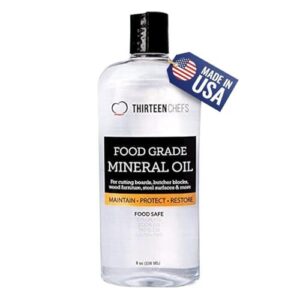
After sharpening your harvesting tools, wood protection through regular oil application keeps grips from cracking and drying during storage. Thirteen Chefs Food Grade Mineral Oil meets food safety standards with USP approval, making it safe for any surface your produce touches.
Application methods are straightforward—just squeeze the bottle onto wooden grips, stainless steel blades, or even bamboo baskets. Surface compatibility extends your preventative maintenance schedule beyond cutting boards to include tool maintenance essentials.
One treatment every three months promotes longlasting tool life, and proper cleaning before oiling maximizes oil longevity while preventing rust formation.
Best For: Gardeners and farmers who need food-safe oil to maintain wooden tool handles, cutting surfaces, and metal blades that come in contact with harvested produce.
- USP-approved and FDA-compliant formula ensures it’s safe for surfaces that touch food, with no harsh chemicals or additives that could contaminate your harvest.
- Easy squeeze-bottle application makes quarterly maintenance simple, and one 8 oz bottle covers multiple tools for up to two years of regular use.
- Works on multiple materials including wood handles, stainless steel blades, and bamboo baskets, preventing rust, cracking, and moisture damage across your entire tool collection.
- Requires reapplication every three months to maintain protection, which means you need to remember regular maintenance schedules during busy growing seasons.
- Heavily dried or damaged wooden handles may need multiple treatments before they’re fully restored, adding time to your initial tool prep.
- Not all wood types respond the same way, so you should test a small area first before treating antique or specialty tools.
Frequently Asked Questions (FAQs)
Whats the best time of day to harvest?
You’ll get the best results during cool morning hours, when temperatures and humidity slow respiration rates. This timing extends postharvest longevity and reduces spoilage compared to midday heat harvests.
How do weather conditions affect harvesting decisions?
Weather can make or break your entire harvest. Temperature impacts, frost damage, precipitation effects, wind influence, and drought effects all determine harvest timing—whether you work during early morning hours, midday heat, or late evening periods when soil moisture stabilizes.
Can I harvest produce after applying pesticides?
You shouldn’t harvest produce immediately after applying pesticides. Pre-harvest intervals (Pesticide PHI) help guarantee residue monitoring stays within legal tolerances.
Washing produce reduces health risks, protecting worker safety and food safety after chemical treatments.
Should I wash produce immediately after harvesting?
You should wash produce after harvesting, but dry it thoroughly. Proper washing and sanitation reduce microbial load, extending shelf life by up to 20%.
Excess moisture, however, accelerates spoilage, so moisture control is essential for fresh produce safety.
How long can harvested produce stay unrefrigerated?
Your fresh-picked produce won’t last forever—most items stay good just 1-3 days at room temperature.
Temperature, humidity, respiration rates, and ethylene production all affect storage duration, so careful postharvest handling matters.
Conclusion
Studies show that up to 30% of harvested produce suffers damage before reaching consumers, with improper handling as the primary culprit. Your garden doesn’t have to contribute to that statistic.
Proper tool usage for harvesting produce protects your investment of time, effort, and resources while delivering unblemished crops to your kitchen. Sharp blades, matched tools, and gentle techniques separate experienced gardeners from those who watch quality slip through their fingers—literally.
- https://www.sciencedirect.com/science/article/pii/S2666154323003216
- https://scholarworks.uark.edu/cgi/viewcontent.cgi?article=1003&context=aectuht
- https://www.farmstandapp.com/60867/7-best-hand-tools-for-efficient-harvesting/
- https://dr.lib.iastate.edu/server/api/core/bitstreams/d31c1301-d95b-488f-9f7d-4ace6d02c94a/content
- https://www.meegle.com/en_us/topics/robotics/robotic-harvesting

